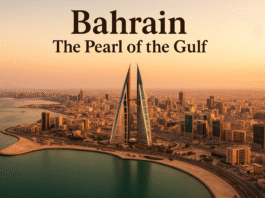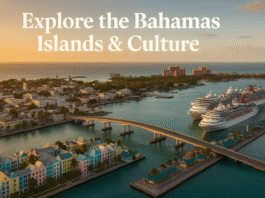Introduction
Bangladesh, a developing South Asian country, skilfully combines its rich cultural legacy with its quick modernisation. Nestled between the northeastern tip of Myanmar and the eastern borders of India, this deltaic gem is sculpted by the Ganges, Brahmaputra, and Meghna, three of the world’s most powerful rivers, creating a region that is as fertile geographically as it is in custom.
Bangladesh has a civilisational history that spans thousands of years, enhanced by layers of colonial, Buddhist, Hindu, and Islamic influence, despite being one of the world’s youngest nations, having gained independence in 1971. Its dynamic garment industry, burgeoning tech scene, and increasing urbanisation coexist with its colourful festivals, vibrant cities, and deeply ingrained Bengali culture.
Bangladesh offers an enticing paradox: one of cultural richness and economic aspiration, of ancient rivers and digital revolutions, from the tranquil tea gardens of Sylhet to the UNESCO Sundarbans mangrove forests to the vibrant city of Dhaka.
We delve deeply into the major historical turning points, geographic diversity, cultural identity, economic development, tourism potential, and distinctive national characteristics that make Bangladesh a nation of not just interest, but also great promise and worldwide significance in this comprehensive guide. Bangladesh has fascinating stories to tell, regardless of your interests—whether you’re an aspiring investor, a world culture student, or just someone trying to get a sense of the spirit of South Asia.
🇦🇸 Geography & Position in the World
Continental and Neighboring Context
Bangladesh is located in the South Asian subregion on the Asian continent. Its neighbours on land include:
- India (to the east, north, and west)
- Myanmar (southern)
- Bengal Bay (to the south)
World Position
With a total area of about 147,570 km2, Bangladesh is one of the most densely populated nations in the world. It is located between latitudes 20°34′ and 26°38′ N and longitudes 88°01′ and 92°41′ E.
Key Geographical Features

- The world’s largest delta system is the Ganges–Brahmaputra Delta.
- The largest mangrove forest on Earth is the Sundarbans.
- The Padma (Ganges), Meghna, and Jamuna are important rivers.
- Sceneries that range from hilly forests to tropical beaches
🏛️ Historical Journey

Ancient Civilizations (Before 13th Century)
- Origins in the Mahajanapadas of antiquity, particularly Vanga
- Agriculture, trade, and relations with South Asian empires (Mauryan, Gupta)
Medieval Era (13th–18th Century)
- The Bengal Sultanate’s rise (influenced by Islam)
- Peak cultural and economic prosperity during the Mughal Empire’s rule
Colonial Rule (18th–20th Century)
- The British East India Company’s 1757 annexation
- Bengal Partition (1905) → Unification in 1912 as a result of widespread demonstrations
- An important hub for the Indian independence movement
Road to Independence
- 1947: After being divided from British India, it becomes East Pakistan.
- 1971: Sheikh Mujibur Rahman’s liberation war and independence
- About 3 million people died between September 1971 and December; India helped Bangladesh gain its independence.
Post-Independence & Modern Era
- Liberation was followed by political upheavals.
- Late 20th century: economic expansion and the rise of democracy
- Today: a developing middle-income nation with a global impact
🎨 Culture & Society
Religion & Festivals
- About 90% of people are Muslims, but there are also some Christians, Buddhists, and Hindus.
- Important holidays include Durga Puja, Buddha Purnima, Pohela Boishakh (Bengali New Year), Eid-ul-Fitr, and Eid-ul-Adha.
Language & Literature
- Official language: Bangla (Bengali)
- Poets such as Rabindranath Tagore have left a rich literary legacy.
- Bengali’s bid to become a national language was sparked by the Language Movement of 1952.
Music, Dance & Visual Arts
- Folk music: Baul, Lalon, and Bhatiali
- Traditional forms: Nazrul Sangeet and Rabindra Sangeet
- Painting, ceramics, and elaborate nakshi kantha are examples of the arts.
Cuisine
- Rice and lentils (dal) are staples.
- Foods: pitha, biriyani, hilsa fish, and street snacks like fuchka and samosas
- Candy: Roshmalai, Sandesh, and Mishti Doi
Family & Social Norms
- Joint families are still prevalent.
- A focus on community, hospitality, and respect
- Strong diaspora: migrant workers’ remittances support economic expansion
📈 Economy & Development
Overview & Growth
- GDP growth of 6–8% on average
- 2015 saw a shift to lower-middle income.
- major exporter of clothing worldwide
- Agriculture—rice, tea, and jute, or “golden fiber”—remains essential.
Key Economic Sectors
- Over 80% of export revenue comes from textiles and apparel.
- Migrant workers’ remittances
- Agriculture: tea, sugarcane, jute, and rice
- Services: transportation, IT, banking, and telecommunication
Infrastructure & Reforms
- Highways, power plants, and the Padma Bridge
- increased exports and facilitated domestic commerce
- Reforms in the financial sector and the growth of microcredit (Grameen Bank, BRAC)
Challenges & Opportunities
- Flooding and climate change vulnerability
- Urban challenges and income inequality
- youthful workforce with startups and new technologies
- India’s strategic potential-The Economic Corridor of Bangladesh

🌍 UN Membership & Global Role
- joined the UN on September 17, 1974.
- participated in peacekeeping operations with between 150,000 and 200,000 personnel.
- Climate action advocates through the LDC group, G77
- Strategic significance in the geopolitics of South Asia
🗺️ Major Cities & Tourism
Dhaka (Capital)
- A megacity with more than 21 million residents
- Landmark locations include Parliament House, Lalbagh Fort, Ahsan Manzil, and secret cafes.
Chittagong
- Port city and business centre
- Attractions include Foy’s Lake, Patenga Beach, and neighbouring hill tracts.
Sylhet
- renowned for Srimangal’s tea estates
- Ratargul Swamp Forest and picturesque locations in Jaflong
Cox’s Bazar

- The longest natural seashore in the world (about 120 km)
- Sunbathing, surfing, and visiting Buddhist temples
Sundarbans (Khulna Division)

- UNESCO World Heritage
- Mangrove forest tours and Bengal tiger habitat
Srimangal & Sylhet Division
- Tribal culture, tea tourism, and waterfalls
- Perfect for those who enjoy the outdoors
Rajshahi & Khulna
- Mango orchards and cultural heritage in Rajshahi
- Khulna’s mangroves, ecotourism, and shrimp farms
✅ Unique Facts
- recognised as the largest man-made tidal bore in the Guinness World Records
- India and Bangladesh’s “Hilsa Treaty” with Bengal
- Listed as one of the fastest-growing apparel economies in the world
- The birthplace of the first rickshaws, with over 3 million
- Rabindra Sangeet, written by Tagore, is devoted to experiences in Bangladesh.
🧭 Travel Guide Tips

- The best time to go is during the dry, festive season, which runs from October to March.
- Visa: E-visas are available in more than 100 countries; some require a visa upon arrival.
- Transportation options include rickshaws, buses, trains, domestic flights, and boats.
- Health and safety: prevent the risk of cholera; get vaccinated
- Bangladeshi Taka (BDT) is the currency; cards are accepted in urban areas.
📄 Summary & Conclusion
Bangladesh is a fascinating combination of growth, vibrancy, and history. It is a symbol of tenacity and promise, from its historic rivers and Mughal heritage to its thriving apparel industry and technologically savvy youth. While Dhaka and Chittagong demonstrate its urban vibrancy, the Sundarbans, Cox’s Bazar, and Sylhet emphasise its natural charm. The nation’s story is one of change, with a culture firmly anchored in language, art, and hospitality—and an expanding international footprint. Bangladesh is more than just a country; it’s a continuous process of development and promise.
- Government of Bangladesh – Official Portal
🌐 https://bangladesh.gov.bd
for confirming national updates, policies, and information.
- UNESCO World Heritage – Sundarbans
🌐 https://whc.unesco.org/en/list/798
discusses conservation initiatives and the listing of Bangladesh’s Sundarbans.
- Bangladesh Bureau of Statistics (BBS)
🌐 http://bbs.gov.bd
source of economic, population, and development indicators.
- Visit Bangladesh (Tourism Board)
🌐 https://visitbangladesh.gov.bd
Travel guides and attractions are available on the official tourism board website.
- World Bank: Bangladesh Overview
🌐 https://www.worldbank.org/en/country/bangladesh
trustworthy information about social advancement and economic growth.
- CIA World Factbook – Bangladesh
🌐 https://www.cia.gov/the-world-factbook/countries/bangladesh/
detailed statistics on population, governance, and geography.
- UNDP – Bangladesh Country Profile
🌐 https://www.bd.undp.org/
Information from the United Nations Development Programme in Bangladesh about gender equality, climate action, development projects, and more.
- BBC Country Profile – Bangladesh
🌐 https://www.bbc.com/news/world-south-asia-12650940
gives a current, unbiased summary of the politics, economy, and current events in Bangladesh.
- Banglapedia – National Encyclopedia of Bangladesh
🌐 http://en.banglapedia.org/index.php?title=Main_Page
A wealth of scholarly and cultural materials for in-depth study of Bangladeshi geography, history, and famous figures.
- Bangladesh Bank – Central Bank of Bangladesh
🌐 https://www.bb.org.bd/
Useful for currency, monetary policy, economic reports, and official financial data.




